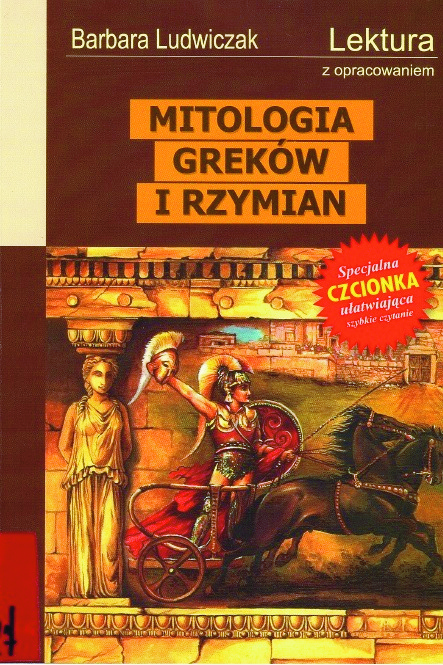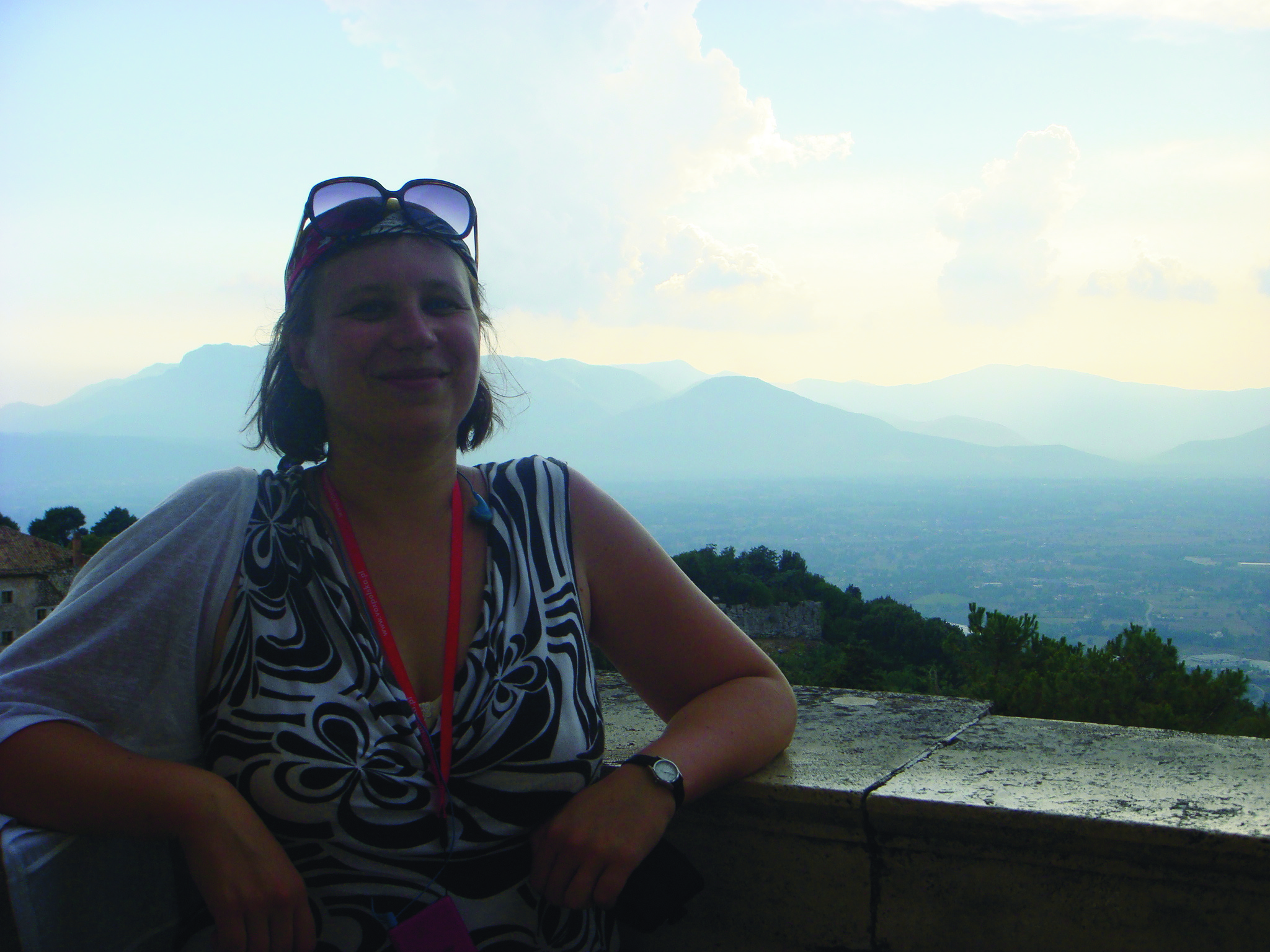Title of the work
Country of the First Edition
Country/countries of popularity
Original Language
First Edition Date
First Edition Details
Barbara Ludwiczak, Mitologia: wierzenia Greków i Rzymian. Kraków: GREG, 2008, 214 pp.
ISBN
Genre
Anthology of myths*
Target Audience
Children (school children)
Cover

Courtesy of Wydawnictwo Greg, the publisher.
Author of the Entry:
Summary: Agnieszka Gąsior, University of Warsaw, aga.gasior@op.pl
Analysis: Hanna Paulouskaya, University of Warsaw, hannapa@al.uw.edu.pl
Peer-reviewer of the Entry:
Katarzyna Marciniak, University of Warsaw, kamar@al.uw.edu.pl
Elżbieta Olechowska, University of Warsaw, elzbieta.olechowska@gmail.com

Photograph courtesy of the Author.
Barbara Ludwiczak
, b. 1980
(Author)
Born in Tarnów, on Halloween of 1980; writer and philologist. Made her debut in 2002 with a short story Teodycea [Theodicy] in “Science Fiction” monthly magazine. After studies in Classics at the Jagiellonian University (graduated in 2005) she taught Latin and Culture in secondary school and college. Currently she works in Zakłady Mechaniczne “Tarnów” [Mechanical Plant “Tarnów”]. Since 2008 she has collaborated with the publishing house GREG, first as the author of Mitologia. Wierzenia Greków i Rzymian [Mythology. Beliefs of the Greeks and Romans], 2008, a book about ancient myths and legends, then, in producing an adaptation of Homer: Przygody Odyseusza [The Adventures of Odysseus], 2010, retelling stories of Iliad and Odyssey. Co-translator (with Marta Kędroń) of Mark Twain’s The Adventures of Tom Sawyer and Adam and Eve’s Diaries. History, philosophy, music, art and various literary genres such as science fiction, space opera, fantasy are among her interests along with many others.
Bio kindly provided by the Author.
Summary
Based on: Katarzyna Marciniak, Elżbieta Olechowska, Joanna Kłos, Michał Kucharski (eds.), Polish Literature for Children & Young Adults Inspired by Classical Antiquity: A Catalogue, Faculty of “Artes Liberales”, Warsaw: University of Warsaw, 2013, 444 pp.
The book is a collection of adaptations of myths ranging from ancient Greek mythology to Roman legends and beliefs. It contains descriptions of individual gods, supernatural heroes and divine creatures, their attributes, nicknames, and ancient iconography. Various stories about their lives illustrate their complex characters. In the first part of the book there are myths of origin, anecdotes about Olympian gods, gods of the air, light, earth and sea, gods of the underworld and those defined by the author as the gods of human fate (Nemesis, Nike, Moirai, Thanatos, Hypnos). In addition, there is also one longer chapter, covering the story of Orpheus and Eurydice, the stories of heroes and the adaptation of Greek epic poems: Iliad and Odyssey. The second part of the book discusses Roman religion and Roman legends, it also includes a short version of Virgil’s Aeneid. The book is designed to present the information clearly, names of gods are in bold letters and many additional materials (such as maps and a dictionary) are provided at the end of the publication.
Analysis
The text is addressed to older students and according to the publisher’s introduction (p. [1]), it aims to help them prepare for school lessons. The book is written briefly and concisely and includes most of the necessary information on Greek and Roman mythology. Typically, the descriptions of the myths are very brief. Only a few of them are longer. These are descriptions of the myth of Eros and Psyche (pp. 28, 30–54), retellings of the Iliad (pp. 118–124) and Odyssey (pp. 128–140). Gods’ profiles include additional information, such as their epithets or information about cults. Differences between Greek and Roman religion are emphasised.
After the parts on Greek mythology (pp. 5–140) and Roman mythology (pp. 143–161), there is an addition entitled Opracowanie [Studies] (pp. 165–186). It includes some information on the theory of myth and oral literature, an interpretation of chosen myths (with a separate subchapter on the myth of Eros and Psyche, pp. 177–179) and mythical inspirations in art and literature. The last part includes only a list of selected references without any description or analysis.
The attention given to the myth of Eros and Psyche in the main part and addition is unusual. This myth does not seem to be highlighted to such an extent in other mythologies for children. The choice of the myth proves that the intended addressees of the text are young people, who might have more interest in the story about romantic relationships and may as well be trying to define their identity. Both ways of interpreting the story are emphasised in the text (p. 177).
Similarly to the Mythology by Wojciech Rzehak (2004), the text includes a comparison of Greek and Roman mythology to the Bible. Parallels between the narratives are briefly listed, and the differences are discussed. The analysis is conducted from a Christian perspective. For example, the author uses an inclusive “us” to identify the readers as members of the Catholic community (p. 175)* or states that the Bible is a text inspired by God (p. 175).
Speaking of the various types of “myths”, she gives examples of contemporary “myths”, such as “an idea of cultural and racial superiority or technical progress ” (p. 172), and the myth of Poland viewed as a bulwark of Christianity – offering a short critical analysis of this concept and its consequences (such as “the attitude of Poles towards Jews, Orthodox Christians, and Muslims”, p. 173). These brief observations may generate further reflection on the topic among the readers and a discussion, a didactically valuable outcome.
* “… tkwiącymi w naszej, katolików, świadomości opowieściami biblijnymi” (the biblical stories rooted in our Catholic mentality, p. 175).
Further Reading
Mitologia [A description of the book at the Publisher’s Website] (accessed: September 22, 2022).


